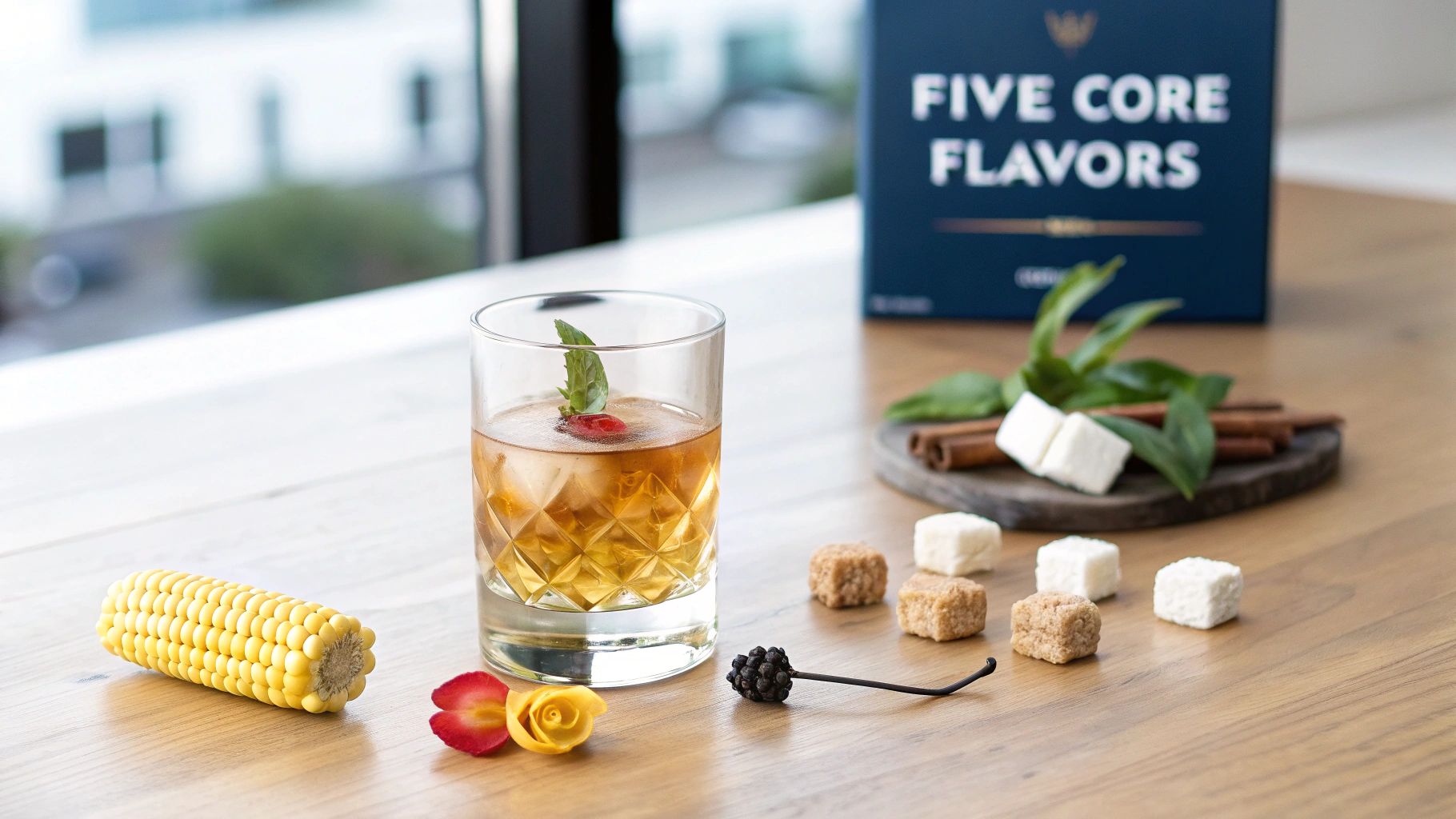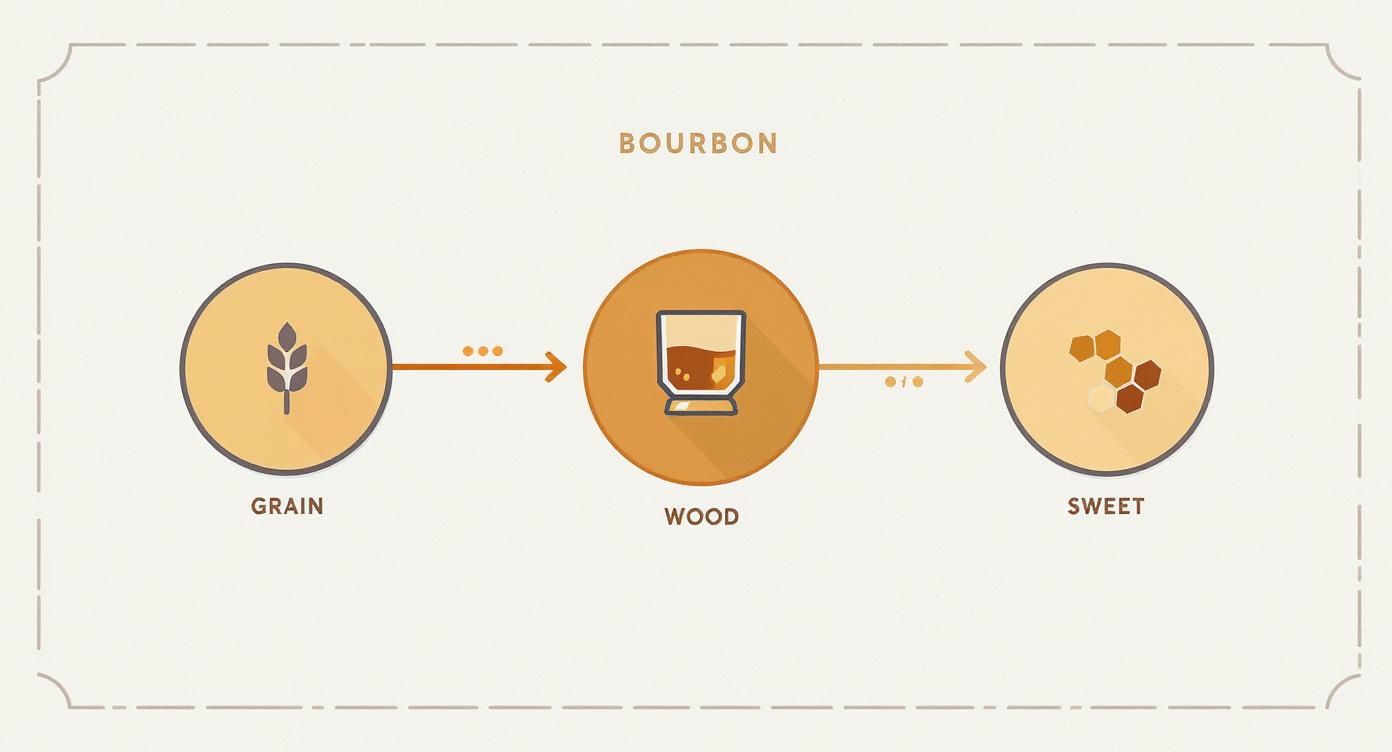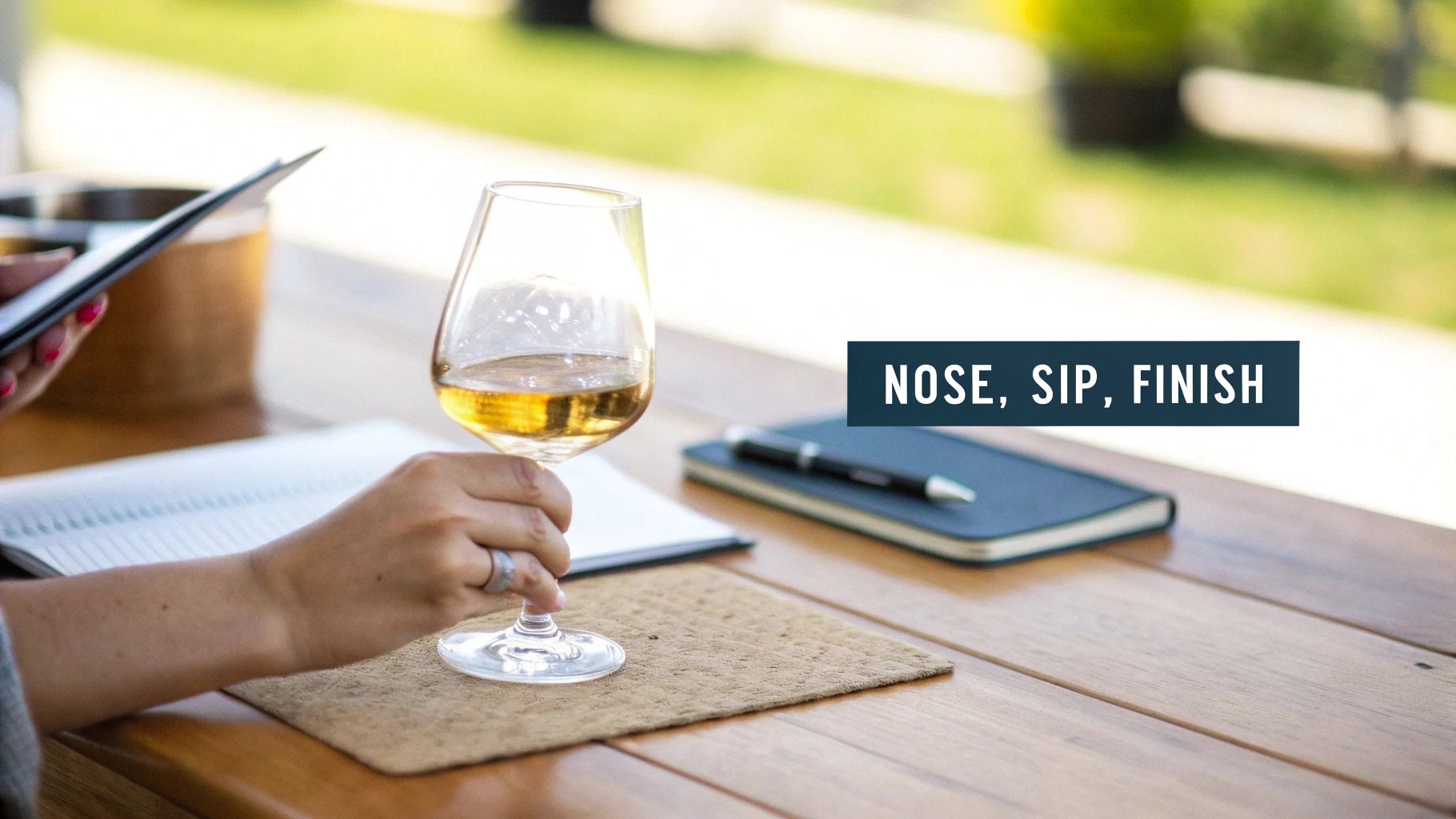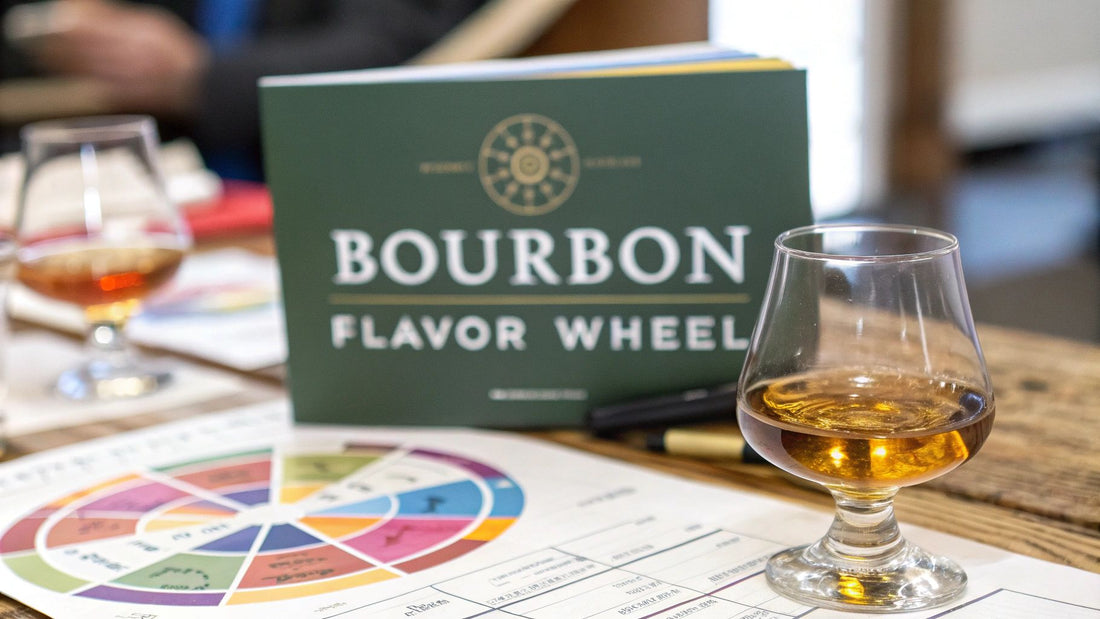Ever find yourself swirling a glass of bourbon, completely stumped on how to describe what you're tasting? It’s a common roadblock, especially for new whiskey drinkers. The bourbon flavor wheel is the perfect tool to get you past it—a visual map designed to help you put words to the complex sensations in your glass.
Think of it as a cheat sheet for your palate. It’s your guide to confidently picking out everything from sweet caramel to a pop of spicy cinnamon, helping you understand your preferences and discover new favorites.
So, What Is a Bourbon Flavor Wheel Anyway?

It’s a lot like a color wheel for an artist. The bourbon flavor wheel isn’t a set of rigid rules you have to memorize, but more of a trusted guide to help build up your tasting vocabulary and your confidence. Instead of just landing on "this is good," you can start to articulate exactly what makes it so enjoyable.
This tool is a game-changer, especially if you’re just starting to explore the wild and wonderful world of American craft whiskey, where unique and unexpected flavor profiles are the name of the game. It helps you pin down what you like, which makes finding your next favorite bottle a whole lot easier.
The Five Core Flavor Families
At its heart, the flavor wheel keeps things simple by organizing hundreds of potential notes into five main categories. This structure gives you a solid starting point for breaking down any bourbon you taste.
- Grain: These are the notes that come straight from the mash bill—corn, rye, wheat, or barley.
- Sweet: Think classic bourbon flavors like vanilla, rich caramel, and honey that develop during barrel aging.
- Wood/Spice: This is where you’ll find the oaky, spicy, and sometimes smoky notes that the charred barrel contributes.
- Fruit: Flavors ranging from bright citrus to dark, jammy cherry, often created by yeast during fermentation and maturation.
- Floral: The more delicate hints of flowers, botanicals, and herbs.
Tip for New Drinkers: Don't feel pressured to find every category in every glass. Start by just trying to identify one or two main families. Is it more sweet or more spicy? That's a great first step!
Getting familiar with these core families is your first real step toward decoding what’s in your glass. The specific combination of a corn-heavy mash bill and aging in new charred oak barrels is what makes this wheel so essential for any bourbon fan. To get a better handle on the fundamentals, check out our guide on what makes whiskey unique.
Decoding the Five Core Bourbon Flavors
Ready to build your tasting vocabulary? The best place to start with the bourbon flavor wheel is by getting to know its five main territories. Each category is like a family of flavors, and understanding them helps you connect what you're smelling and tasting to how the whiskey was actually made.
Think of it as a visual map that breaks down where a bourbon’s flavor comes from. It all boils down to three key sources: Grain, Wood, and Sweet, which are the foundational pillars of any good bourbon’s profile.

This chart gives you a quick visual on how the final flavor is a team effort between the mash bill, the barrel, and the long, slow aging process. Now, let's walk through all five sections of the wheel.
Grain and Sweet Aromatics
First up, you have Grain. These are the notes that come directly from the bourbon’s recipe, or mash bill. Since bourbon legally has to be at least 51% corn, you’ll almost always find a base note of sweet corn, cornbread, or maybe even grits. If rye is the next grain in line, you might pick up on spicy rye bread or a crack of pepper. For a wheated bourbon—a style that's become a favorite in many American craft whiskey lineups from distilleries like Frey Ranch or Garrison Brothers—you'll often get softer notes of toasted bread or breakfast cereal.
Right next door is the Sweet category. These are the classic, comforting flavors that make bourbon so darn approachable, especially for beginners. We’re talking about notes like caramel, vanilla, toffee, and rich honey. These flavors are literally born inside the new charred oak barrel, as the spirit pulls out caramelized wood sugars during maturation.
Wood, Spice, Fruit, and Floral
The Wood/Spice section is what gives bourbon its bold backbone. This is where you’ll find those distinct flavors of charred oak, toasted nuts, and old leather. This category also covers spicy notes like cinnamon, black pepper, and clove that add a wonderful complexity and warmth, especially on the finish.
Finally, we land on Fruit & Floral. These notes are often a gift from the yeast during fermentation. In fact, different yeast strains are one of the key secrets distillers use to create their signature profiles. You can dive deeper into the magic of yeast in our article on how whiskey wizards create unique flavors.
These fruity and floral notes are often the most surprising for new drinkers. One bourbon might have bright hints of apple and citrus, while another delivers rich, dark cherry or plum. It’s all part of the discovery.
To help you keep track of these key categories, here’s a quick summary of what to look for and where those flavors come from.
Bourbon Flavor Wheel Categories and Common Notes
| Flavor Category | Common Tasting Notes | Origin in Production |
|---|---|---|
| Grain | Sweet Corn, Cornbread, Cereal, Toasted Bread, Rye Spice | The mash bill (corn, rye, wheat, barley) |
| Sweet | Caramel, Vanilla, Honey, Brown Sugar, Toffee, Butterscotch | Charred oak barrel aging, caramelized wood sugars |
| Wood/Spice | Charred Oak, Tobacco, Leather, Cinnamon, Black Pepper, Clove | Barrel aging, interaction between spirit and wood |
| Fruit | Cherry, Apple, Plum, Citrus Peel, Dried Fruit, Berries | Yeast strains during fermentation, formation of esters |
| Floral | Honeysuckle, Rose, Orange Blossom, Mint, Fresh-Cut Grass | Yeast strains during fermentation, also influenced by grain type |
Getting familiar with these five categories is the first major step to confidently identifying what’s in your glass. If you're curious about the chemistry and perception behind it all, exploring the broader science of flavor can be a fascinating rabbit hole to go down.
Why the Charred Oak Barrel Is Everything

If the mash bill is bourbon’s soul, then the new charred American oak barrel is its heart. This isn’t just a simple storage container; it's an active, essential ingredient that shapes the vast majority of flavors we associate with America’s native spirit. By law, bourbon must be aged in a new, charred oak container—a strict rule that sets it apart from many other whiskies around the world.
This is where the real magic happens. When a barrel is charred, the intense heat caramelizes the wood's natural sugars. As the unaged whiskey—often called "white dog"—matures inside, it slowly pulls these sugars from the wood, creating the signature sweet notes of vanilla, caramel, and toffee that are the foundation of any bourbon flavor wheel.
The Role of Char and Climate
The level of char inside the barrel plays a massive role in shaping the final taste. A distiller can choose anything from a light toast to a deep, heavy burn known as an "alligator char" for its scaly appearance. A heavier char often contributes deeper, richer notes of smoke, dark chocolate, and roasted coffee.
Many American craft whiskey brands like Westward Whiskey love to experiment with different char levels to create unique flavor profiles, which offers a fun challenge for drinkers trying to pinpoint specific notes. This intimate dance between the spirit and the wood is where a bourbon’s true character is born. For a deeper dive, you can learn more about how aging barrels for whiskey shape the final product.
The barrel doesn't just add flavor; it also acts as a natural filter. The charcoal layer helps strip away harsher, unwanted compounds from the young spirit, resulting in a smoother, more refined bourbon over time.
But the transformation doesn't stop with the char. The dramatic temperature swings in places like Kentucky cause the barrel staves to expand and contract throughout the year. In the summer heat, the whiskey is forced deep into the wood; in the winter cold, it retreats. This constant "breathing" is crucial for extracting color, tannins, and complex flavors of oak, leather, and baking spice from the barrel.
In fact, this aging process is profoundly influential. Studies show that these temperature fluctuations over the typical 4-8 years of barrel aging are responsible for more than 70% of a bourbon’s complex flavor characteristics. To get the full story on this fascinating history, you can discover more insights about bourbon's evolution on pourmore.com.
How to Use the Bourbon Flavor Wheel: A Simple Guide
Alright, you've got the theory down, but now for the fun part: putting that bourbon flavor wheel to work. This is where a simple sip transforms into a full-on discovery, helping you pick out flavors you never knew were there. Forget about getting it "right" or "wrong"—this is all about paying attention, building your palate, and having a good time.
The whole process boils down to three simple stages: nosing, tasting, and appreciating the finish. Think of the flavor wheel as your compass, guiding you as you explore what the bourbon has to offer at each step. It’s a straightforward approach that makes tasting feel less like a test and more like an adventure.
The Three Stages of Tasting
First things first, pour a little bourbon into a glass. A Glencairn is perfect because its shape is designed to concentrate all those amazing aromas. Give the glass a gentle swirl to wake up the spirit, and let's dive in.
-
Nosing (Aroma): Before the whiskey even touches your lips, bring the glass up to your nose. Part your lips just a bit and take a gentle sniff. What's the very first scent that hits you? Is it something sweet and familiar, like caramel bubbling up from the barrel? Or maybe it’s more on the grainy side, like a warm slice of cornbread? That first impression is everything—your sense of smell does most of the heavy lifting when it comes to flavor.
-
Tasting (Palate): Now, take a small sip and let it roll across your entire tongue. Hold it there for a second. What jumps out at you? This is where you can start digging a little deeper. If you're getting fruit, is it a bright, zesty citrus or more of a rich, dark cherry? Are there any spices making an appearance, like a dash of cinnamon or a crack of black pepper?
-
The Finish (Lingering Notes): After you swallow, just pause and pay attention to the flavors that hang around. That's the finish. Does it disappear quickly, or does it linger for a while? Do those sweet notes from the beginning stick around, or does a spicy, oaky character take over for the grand finale?
Pro Tip for New Drinkers: If that initial alcohol heat feels a little intense, add a single drop of water. It's amazing how much this can open up the bourbon, toning down the burn and letting the more delicate fruit and floral notes shine through.
For your first crack at a guided tasting, you’ll want a bourbon with some complexity but also a clear, easy-to-read profile. A well-made American craft whiskey is an excellent starting point. Something like a bottle from Widow Jane is a fantastic choice; their whiskeys often have really distinct notes that are perfect for a beginner trying to match what they're tasting to the bourbon flavor wheel.
Bringing the Flavor Wheel to Life
So, how does this all work in the real world? Let's take the bourbon flavor wheel from a neat diagram to an actual tasting experience. We'll walk through a hypothetical pour from a modern American craft distillery, and I'll show you exactly how to pin the aromas and flavors you're finding to their home on the wheel.
Picture this: you've just poured a beautiful amber-colored bourbon into your glass. Before you even think about tasting it, bring it up to your nose. That first impression, the aroma, hits you with a rich wave of sweet vanilla and maybe a little butterscotch—classic notes from the Sweet category.
As you nose it a bit more, something else comes through. It's a warm, comforting smell of toasted cornbread, a dead giveaway of the bourbon’s high-corn mash bill, which you can place right in the Grain section of the wheel.
From First Sip to Finish
Alright, time for that first sip. As the whiskey washes over your tongue, a bright burst of dark cherry and orange zest from the Fruit & Floral category jumps out. It's a lovely initial sweetness.
But it doesn't stay there. That sweetness quickly gives way to a pleasant warmth, revealing spicy notes of cinnamon and a hint of nutmeg. That's the barrel talking, and it belongs in the Wood/Spice section. As you swallow, the influence of that charred oak barrel really comes into focus, deepening the spice and adding a distinct charred character that gives the bourbon its backbone.
The finish is the final chapter of your tasting. It's the ghost of the whiskey that hangs around after you've swallowed, and a long, memorable finish is usually the signature of a really well-made spirit.
In our imaginary pour, the finish is fantastic—long and satisfying. Those spicy notes from the palate begin to fade out, making way for deeper, richer flavors of aged leather and sweet toffee to emerge.
This whole journey—from the sweet nose to the spicy palate and that complex, lingering finish—is a perfect example of how the flavor wheel acts as your map, helping you identify and appreciate every single note hiding in your glass.
Common Questions About Tasting Bourbon
As you start getting familiar with the bourbon flavor wheel, a few questions are bound to pop up. That’s totally normal—developing your palate is a journey, not a pop quiz. Let's walk through some of the most common hurdles to get you tasting with more confidence.
What If I Can’t Find Any Notes?
This is probably the biggest one, and it's a super common fear for new drinkers. Don't worry, and don't overthink it. Instead of hunting for a very specific note like "dried apricot," just start broad.
Ask yourself the simple questions first: "Is this sweet? Is it spicy?" Use the five main categories of the flavor wheel as your guideposts. With a little practice, those big, general feelings will start sharpening into more specific notes. You’ll get there.
How Does the Wheel Apply to Different Bourbons?
Another great question is how the wheel works for different styles, like a high-rye versus a wheated bourbon. The wheel is a universal tool, but it shines a light on what makes each style unique.
- For a high-rye bourbon: You’ll probably find yourself spending more time in the Wood/Spice section of the wheel, pulling out notes like black pepper, cinnamon, and maybe a little mint.
- For a wheated bourbon: Your attention might shift over to the Grain and Sweet categories, where you'll find those softer notes of toasted bread, honey, and caramel.
The real beauty of the flavor wheel is its flexibility. It gives you a framework to understand why a wheated bourbon from an American craft distillery tastes so different from a bold, spicy rye-heavy bourbon. It all comes back to the recipe and the process.
Trusting your own palate is the most important part. The whole tasting experience has become much more consistent since 1870, when George Garvin Brown first sold Old Forester in sealed glass bottles. It was a massive step in standardizing bourbon quality, because before that, flavor could vary wildly from one barrel to the next. You can read more about bourbon's flavorful history on thewhiskeyfool.com.
At the end of the day, the goal is just to have fun and figure out what you genuinely enjoy drinking.
Ready to put your palate to the test without any bias? At Blind Barrels, we send you curated blind tasting kits that feature incredible American craft whiskeys. It's the most exciting way to find your next favorite bottle based purely on what’s in the glass. Start your blind tasting adventure today!
